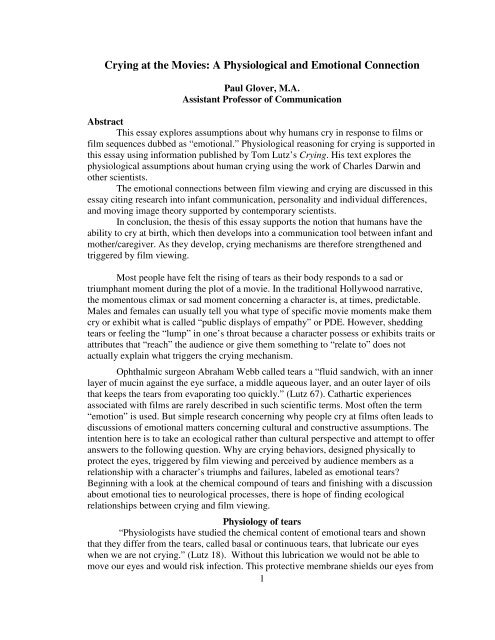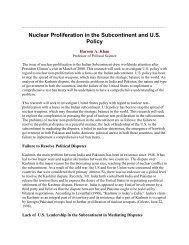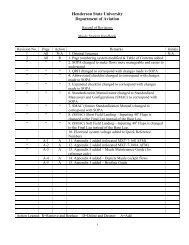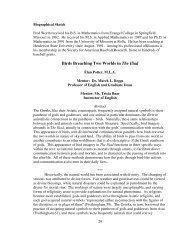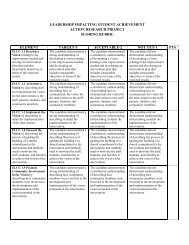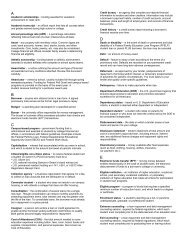Crying at the Movies: A Physiological and Emotional Connection ...
Crying at the Movies: A Physiological and Emotional Connection ...
Crying at the Movies: A Physiological and Emotional Connection ...
You also want an ePaper? Increase the reach of your titles
YUMPU automatically turns print PDFs into web optimized ePapers that Google loves.
<strong>Crying</strong> <strong>at</strong> <strong>the</strong> <strong>Movies</strong>: A <strong>Physiological</strong> <strong>and</strong> <strong>Emotional</strong> <strong>Connection</strong><br />
Paul Glover, M.A.<br />
Assistant Professor of Communic<strong>at</strong>ion<br />
Abstract<br />
This essay explores assumptions about why humans cry in response to films or<br />
film sequences dubbed as “emotional.” <strong>Physiological</strong> reasoning for crying is supported in<br />
this essay using inform<strong>at</strong>ion published by Tom Lutz’s <strong>Crying</strong>. His text explores <strong>the</strong><br />
physiological assumptions about human crying using <strong>the</strong> work of Charles Darwin <strong>and</strong><br />
o<strong>the</strong>r scientists.<br />
The emotional connections between film viewing <strong>and</strong> crying are discussed in this<br />
essay citing research into infant communic<strong>at</strong>ion, personality <strong>and</strong> individual differences,<br />
<strong>and</strong> moving image <strong>the</strong>ory supported by contemporary scientists.<br />
In conclusion, <strong>the</strong> <strong>the</strong>sis of this essay supports <strong>the</strong> notion th<strong>at</strong> humans have <strong>the</strong><br />
ability to cry <strong>at</strong> birth, which <strong>the</strong>n develops into a communic<strong>at</strong>ion tool between infant <strong>and</strong><br />
mo<strong>the</strong>r/caregiver. As <strong>the</strong>y develop, crying mechanisms are <strong>the</strong>refore streng<strong>the</strong>ned <strong>and</strong><br />
triggered by film viewing.<br />
Most people have felt <strong>the</strong> rising of tears as <strong>the</strong>ir body responds to a sad or<br />
triumphant moment during <strong>the</strong> plot of a movie. In <strong>the</strong> traditional Hollywood narr<strong>at</strong>ive,<br />
<strong>the</strong> momentous climax or sad moment concerning a character is, <strong>at</strong> times, predictable.<br />
Males <strong>and</strong> females can usually tell you wh<strong>at</strong> type of specific movie moments make <strong>the</strong>m<br />
cry or exhibit wh<strong>at</strong> is called “public displays of emp<strong>at</strong>hy” or PDE. However, shedding<br />
tears or feeling <strong>the</strong> “lump” in one’s thro<strong>at</strong> because a character possess or exhibits traits or<br />
<strong>at</strong>tributes th<strong>at</strong> “reach” <strong>the</strong> audience or give <strong>the</strong>m something to “rel<strong>at</strong>e to” does not<br />
actually explain wh<strong>at</strong> triggers <strong>the</strong> crying mechanism.<br />
Ophthalmic surgeon Abraham Webb called tears a “fluid s<strong>and</strong>wich, with an inner<br />
layer of mucin against <strong>the</strong> eye surface, a middle aqueous layer, <strong>and</strong> an outer layer of oils<br />
th<strong>at</strong> keeps <strong>the</strong> tears from evapor<strong>at</strong>ing too quickly.” (Lutz 67). C<strong>at</strong>hartic experiences<br />
associ<strong>at</strong>ed with films are rarely described in such scientific terms. Most often <strong>the</strong> term<br />
“emotion” is used. But simple research concerning why people cry <strong>at</strong> films often leads to<br />
discussions of emotional m<strong>at</strong>ters concerning cultural <strong>and</strong> constructive assumptions. The<br />
intention here is to take an ecological r<strong>at</strong>her than cultural perspective <strong>and</strong> <strong>at</strong>tempt to offer<br />
answers to <strong>the</strong> following question. Why are crying behaviors, designed physically to<br />
protect <strong>the</strong> eyes, triggered by film viewing <strong>and</strong> perceived by audience members as a<br />
rel<strong>at</strong>ionship with a character’s triumphs <strong>and</strong> failures, labeled as emotional tears?<br />
Beginning with a look <strong>at</strong> <strong>the</strong> chemical compound of tears <strong>and</strong> finishing with a discussion<br />
about emotional ties to neurological processes, <strong>the</strong>re is hope of finding ecological<br />
rel<strong>at</strong>ionships between crying <strong>and</strong> film viewing.<br />
Physiology of tears<br />
“Physiologists have studied <strong>the</strong> chemical content of emotional tears <strong>and</strong> shown<br />
th<strong>at</strong> <strong>the</strong>y differ from <strong>the</strong> tears, called basal or continuous tears, th<strong>at</strong> lubric<strong>at</strong>e our eyes<br />
when we are not crying.” (Lutz 18). Without this lubric<strong>at</strong>ion we would not be able to<br />
move our eyes <strong>and</strong> would risk infection. This protective membrane shields our eyes from<br />
1
<strong>the</strong> outside world. Ophthalmologists classify three different kinds of tears. Basal tears are<br />
<strong>the</strong> continuous tears th<strong>at</strong> lubric<strong>at</strong>e our eyeballs. Reflex or irritant tears are produced when<br />
we get poked in <strong>the</strong> eye (or anticip<strong>at</strong>e danger to eyes) or we chop onions. Psychic or<br />
emotional tears are caused by communic<strong>at</strong>ive <strong>and</strong> specific feeling st<strong>at</strong>es. As noticed,<br />
<strong>the</strong>se tears have separ<strong>at</strong>e functions <strong>and</strong> <strong>the</strong>y also have different concentr<strong>at</strong>ions of<br />
“chemicals, hormones <strong>and</strong> proteins.” (Lutz 68).<br />
The lacrimal system is wh<strong>at</strong> all three types of tears have in common. This system<br />
has secretory <strong>and</strong> excretory functions th<strong>at</strong> produce tears <strong>and</strong> drain <strong>the</strong>m. The main<br />
lacrimal gl<strong>and</strong>, loc<strong>at</strong>ed between a shallow depression in <strong>the</strong> frontal bone <strong>and</strong> <strong>the</strong> eyeball,<br />
is responsible for producing tears stimul<strong>at</strong>ed by irrit<strong>at</strong>ion or emotion. There are many<br />
smaller, accessory lacrimal gl<strong>and</strong>s th<strong>at</strong> also contribute to basal tears. Basal tears are<br />
produced <strong>at</strong> <strong>the</strong> r<strong>at</strong>e of one to two microliters a minute, which is approxim<strong>at</strong>ely five to ten<br />
ounces a day depending on <strong>the</strong> size of <strong>the</strong> eyeball. During this daily process some of <strong>the</strong><br />
fluid evapor<strong>at</strong>es between blinks <strong>and</strong> some is drained through small, permanent openings<br />
<strong>at</strong> <strong>the</strong> nose end of each eyelid on a slight elev<strong>at</strong>ion of tissue known as <strong>the</strong> papilla<br />
lacrimalis. “Tears drain through <strong>the</strong> puncta into ducts th<strong>at</strong> drain into <strong>the</strong> lacrimal sac<br />
called <strong>the</strong> canaliculis. From <strong>the</strong> lacrimal sac <strong>the</strong> tears flow into <strong>the</strong> nasolacrimal, which<br />
empties into <strong>the</strong> nose.” (Lutz 70). When tears begin to overflow, perhaps due to irrit<strong>at</strong>ion<br />
or emotions provoked during movie viewing, <strong>the</strong> puncta is unable to h<strong>and</strong>le <strong>the</strong> flow <strong>and</strong><br />
tears drain outward over <strong>the</strong> eyelids. This is an autom<strong>at</strong>ic biological reaction we call<br />
crying.<br />
Tears are composed of w<strong>at</strong>er, mucin, <strong>and</strong> oils along with antibacterial proteins,<br />
immunoglobins, glucose, urea <strong>and</strong> salts. In 1957, UCLA researcher Robert Brunish<br />
concluded “emotional tears had a higher protein concentr<strong>at</strong>ion than reflex tears <strong>and</strong> <strong>the</strong><br />
amount of various proteins-lysozome, globulin, <strong>and</strong> albumin-varied in <strong>the</strong> two kinds of<br />
tears as well.” (Lutz 102). These findings were confirmed twenty years l<strong>at</strong>er by<br />
researcher William Frey who was able to make <strong>the</strong> distinctions by collecting tears<br />
produced by subjects exposed to ei<strong>the</strong>r a tearjerker film (including 1971’s “Brian’s<br />
Song”) or onions. The findings also supported distinctions between emotional tears <strong>and</strong><br />
reflex tears <strong>and</strong> allowed researchers to make determin<strong>at</strong>ions concerning <strong>the</strong> activ<strong>at</strong>ion of<br />
particular tears.<br />
The following illustr<strong>at</strong>ions map <strong>the</strong> lacrimal system:<br />
2
Early Assumptions about <strong>Crying</strong><br />
The history of lacrim<strong>at</strong>ion d<strong>at</strong>es back to <strong>the</strong> Hippocr<strong>at</strong>ic writers <strong>and</strong> European<br />
medicine throughout <strong>the</strong> Renaissance. Unfortun<strong>at</strong>ely, many of <strong>the</strong> writings, though<br />
<strong>at</strong>tempting to focus on <strong>the</strong> brain <strong>and</strong> its p<strong>at</strong>hways, became confounded by spiritual<br />
connections. For instance, Rene Descartes demonstr<strong>at</strong>ed in The Passions of <strong>the</strong> Soul<br />
(1649) th<strong>at</strong> he understood <strong>the</strong> circul<strong>at</strong>ion of <strong>the</strong> blood <strong>and</strong> th<strong>at</strong> <strong>the</strong> nerves in <strong>the</strong> brain<br />
were necessary for sens<strong>at</strong>ion <strong>and</strong> perception; but he could not resist asserting his belief<br />
th<strong>at</strong> <strong>the</strong> brain <strong>and</strong> nerves contained “a certain very subtle air or wind which is called <strong>the</strong><br />
animal spirits” which move through <strong>the</strong> body anim<strong>at</strong>ing muscles <strong>and</strong> making action<br />
possible. Descartes also expressed ideas concerning bodies moving on <strong>the</strong>ir own, without<br />
any help from <strong>the</strong> soul or mind. “He uses <strong>the</strong> example of a friend thrusting a h<strong>and</strong> into<br />
our face; we shut our eyes <strong>and</strong> wince, even if we know our friend would never hurt us.”<br />
(Lutz 74).<br />
Eventually, dissection replaced <strong>the</strong> classical paradigms of philosophical<br />
explan<strong>at</strong>ions of tears, <strong>and</strong> <strong>at</strong>tempts to map <strong>the</strong> physiology of gl<strong>and</strong>s; blood <strong>and</strong> organs<br />
were used for research. Niels Stensen’s An<strong>at</strong>omical Observ<strong>at</strong>ions of <strong>the</strong> Gl<strong>and</strong>s of <strong>the</strong><br />
5
Eye & Their New Vessels <strong>the</strong>reby Revealing <strong>the</strong> True Source of Tears (1662) gave a<br />
revised explan<strong>at</strong>ion of tears based on <strong>the</strong> dissection of a sheep’s head. This was first in<br />
suggesting <strong>the</strong> centrality of <strong>the</strong> lacrimal gl<strong>and</strong>s, though he was l<strong>at</strong>er proven wrong in his<br />
assumption th<strong>at</strong> <strong>the</strong> puncta produced tears r<strong>at</strong>her than draining <strong>the</strong>m. In 1792, French<br />
an<strong>at</strong>omist <strong>and</strong> surgeon Jacques-Francois-Marie Duverney demonstr<strong>at</strong>ed <strong>the</strong> source of<br />
tears in <strong>the</strong> lacrimal gl<strong>and</strong> <strong>and</strong> <strong>the</strong>ir p<strong>at</strong>hways by first describing <strong>the</strong> important muscles<br />
<strong>at</strong>tached to <strong>the</strong> eyelids <strong>and</strong> <strong>the</strong> gl<strong>and</strong>s. Johann Rosenmuller described <strong>the</strong> an<strong>at</strong>omy of <strong>the</strong><br />
gl<strong>and</strong> in 1797 <strong>and</strong> in <strong>the</strong> 1820’s Karl Ernst von Baer studied <strong>the</strong> embryology of <strong>the</strong><br />
lacrimal excretory system. In 1860, Hungarian physician Jan Nepomuk Czermak<br />
identified some of <strong>the</strong> nerves th<strong>at</strong> enerv<strong>at</strong>e <strong>the</strong> lacrimal gl<strong>and</strong>s. These discoveries <strong>and</strong><br />
writings demonstr<strong>at</strong>ed a better underst<strong>and</strong>ing of how <strong>the</strong> body works than previous<br />
writings th<strong>at</strong> tried to include passions <strong>and</strong> emotions within philosophical taxonomies th<strong>at</strong><br />
Lutz describes as, “each one goofier than <strong>the</strong> next.” (76). But collectively, <strong>the</strong>se findings<br />
set <strong>the</strong> stage for Charles Darwin’s contributions to our underst<strong>and</strong>ing of <strong>the</strong> physiology of<br />
tears.<br />
Darwin’s The Expressions of Emotions in Man <strong>and</strong> Animals (1872) addressed<br />
larger questions about bodily origin <strong>and</strong> function of emotion in general, <strong>and</strong> crying in<br />
particular. He st<strong>at</strong>ed th<strong>at</strong> humans <strong>and</strong> mammals express emotion in order to allevi<strong>at</strong>e<br />
distress. “Infants, for instance, when <strong>the</strong>y suffer even moder<strong>at</strong>e pain, cry out violently for<br />
<strong>the</strong> sole purpose of communic<strong>at</strong>ing <strong>the</strong>ir discomfort.” (Lutz 77). He st<strong>at</strong>ed th<strong>at</strong> babies<br />
who can communic<strong>at</strong>e get fed when hungry more regularly than those who cannot <strong>and</strong><br />
concluded th<strong>at</strong> crying out is a st<strong>and</strong>ard mammalian behavior; tears are simply <strong>the</strong><br />
unintended side effects of <strong>the</strong> distress calls. During <strong>the</strong>se distress calls, <strong>the</strong> infants also<br />
strenuously contract <strong>the</strong> muscles around <strong>the</strong> eye. Based on centrality of <strong>the</strong> lacrimal<br />
system, noted by Stensen in his sheep’s head dissection observ<strong>at</strong>ions, <strong>the</strong>se contractions<br />
also affect <strong>the</strong> lacrimal gl<strong>and</strong> <strong>and</strong> its accessory gl<strong>and</strong>s. Darwin used six photographs of<br />
crying infants to illustr<strong>at</strong>e his point:<br />
The corrug<strong>at</strong>ors of <strong>the</strong> brow seem to be <strong>the</strong> first muscles to<br />
contract; <strong>and</strong> <strong>the</strong>se draw <strong>the</strong> eyebrows downwards <strong>and</strong><br />
inwards toward <strong>the</strong> base of <strong>the</strong> nose, causing vertical<br />
furrows, th<strong>at</strong> is a frown, to appear between <strong>the</strong> eyebrows; <strong>at</strong><br />
<strong>the</strong> same time <strong>the</strong>y cause <strong>the</strong> disappearance of <strong>the</strong><br />
transverse wrinkles across <strong>the</strong> forehead. The orbicular<br />
muscles contract almost simultaneously with <strong>the</strong><br />
corrug<strong>at</strong>ors, <strong>and</strong> produce wrinkles all around <strong>the</strong> eyes; <strong>the</strong>y<br />
appear, however, to be enabled to contract with gre<strong>at</strong>er<br />
force, as soon as <strong>the</strong> contraction of <strong>the</strong> corrug<strong>at</strong>ors has<br />
given <strong>the</strong>m some support. Lastly, <strong>the</strong> pyramidal muscles of<br />
<strong>the</strong> nose contract; <strong>and</strong> <strong>the</strong>se draw <strong>the</strong> eyebrows <strong>and</strong> <strong>the</strong> skin<br />
of <strong>the</strong> forehead still lower down, producing short,<br />
transverse wrinkles across <strong>the</strong> base of <strong>the</strong> nose…When<br />
<strong>the</strong>se muscles are strongly contracted, those running to <strong>the</strong><br />
upper lip likewise contract <strong>and</strong> raise <strong>the</strong> upper lip…The<br />
raising of <strong>the</strong> upper lip draws upward <strong>the</strong> flesh of <strong>the</strong> upper<br />
parts of <strong>the</strong> cheek, <strong>and</strong> produces a strongly marked fold on<br />
6
each cheek, <strong>the</strong> naso-labial fold, which runs from near <strong>the</strong><br />
wings of <strong>the</strong> nostrils to <strong>the</strong> corners of <strong>the</strong> mouth <strong>and</strong> below<br />
<strong>the</strong>m. (Lutz 79).<br />
He also used <strong>the</strong>se findings to describe <strong>the</strong> muscular changes around <strong>the</strong> mouth,<br />
<strong>the</strong> changes in respir<strong>at</strong>ion <strong>and</strong> circul<strong>at</strong>ion, <strong>and</strong> o<strong>the</strong>r physical manifest<strong>at</strong>ions th<strong>at</strong><br />
accompany crying. Darwin’s research perme<strong>at</strong>ed o<strong>the</strong>r sciences concerning crying <strong>and</strong><br />
Herbert Spencer referenced <strong>the</strong>se manifest<strong>at</strong>ions l<strong>at</strong>er in Principles of Psychology (1855).<br />
However, Darwin’s records remain more detailed <strong>and</strong> accur<strong>at</strong>e.<br />
Darwin’s main conclusion is th<strong>at</strong>, “weeping is an incidental result, as purposeless<br />
as <strong>the</strong> secretion of tears from a blow outside <strong>the</strong> eye, or as a sneeze from <strong>the</strong> retina being<br />
affected by a bright light.” The prolonged screaming of an infant leads to “<strong>the</strong> gorging of<br />
<strong>the</strong> blood vessels of <strong>the</strong> eye” due to <strong>the</strong> increased respir<strong>at</strong>ion th<strong>at</strong> accompanies crying.<br />
The “gorging” floods <strong>the</strong> eyeball <strong>and</strong> surrounding tissue with blood.<br />
This engorgement leads, <strong>at</strong> first to consciously <strong>and</strong> <strong>at</strong> last<br />
habitually, to <strong>the</strong> contraction of muscles around <strong>the</strong> eyes in<br />
order to protect <strong>the</strong> veins <strong>and</strong> arteries from <strong>the</strong> increased<br />
pressure. These contractions squeeze <strong>the</strong> tear ducts, which,<br />
as <strong>the</strong>y secrete fur<strong>the</strong>r help cool <strong>the</strong> overhe<strong>at</strong>ed <strong>and</strong><br />
engorged eyeballs. (Lutz 79).<br />
This suggests th<strong>at</strong> Darwin considered emotional tears <strong>the</strong> same as reflex tears <strong>and</strong><br />
separ<strong>at</strong>ed any connection between crying <strong>and</strong> “animal spirits”.<br />
Infantile Consider<strong>at</strong>ions<br />
The reason babies cry <strong>at</strong> birth is not known but very soon <strong>the</strong>reafter <strong>the</strong> crying<br />
becomes communic<strong>at</strong>ion between baby <strong>and</strong> mo<strong>the</strong>r. In 1980, Murry <strong>and</strong> Murry<br />
referenced Alfred Adler who suggested in The Psychology of Early Childhood th<strong>at</strong> an<br />
infant’s first cry “represents an overwhelming sense of inferiority <strong>at</strong> thus suddenly being<br />
confronted by reality without ever having had to deal with its problems” <strong>and</strong> to <strong>the</strong><br />
people present <strong>at</strong> childbirth it is a “welcome sign th<strong>at</strong> <strong>the</strong> infant is bre<strong>at</strong>hing normally.”<br />
He went on to say th<strong>at</strong>, “animals do not cry <strong>at</strong> birth…on rare occasions babies cry in<br />
utero <strong>and</strong> such a cry can be heard if <strong>the</strong> membranes have ruptured.” (Murry & Murry 7).<br />
It is established when humans begin crying, thus contracting muscles <strong>and</strong> setting <strong>the</strong><br />
lacrimal system into motion. Darwin had proved th<strong>at</strong> <strong>the</strong> capacities to shed tears is<br />
inherent, whe<strong>the</strong>r <strong>the</strong> tears are incidental or not, but <strong>the</strong> reasons why are not as simple.<br />
Darwin’s research into <strong>the</strong> types of inform<strong>at</strong>ion contained within infant crying is<br />
considered important in <strong>the</strong> area of infant non-verbal communic<strong>at</strong>ion. In 1964 M.D.<br />
Sheridan st<strong>at</strong>ed in Monthly Bulletin of <strong>the</strong> Ministry of Health <strong>and</strong> <strong>the</strong> Public Health<br />
Labor<strong>at</strong>ory Services th<strong>at</strong>, “Infants communic<strong>at</strong>e [non-verbally] with <strong>the</strong>ir mo<strong>the</strong>rs by<br />
crying, w<strong>at</strong>ching her, smiling, laughing, playing…frowning, pushing her away <strong>and</strong> by<br />
vocaliz<strong>at</strong>ions leading to speech.” (Murry & Murry 5). Researching <strong>the</strong> way humans seek,<br />
perceive <strong>and</strong> process inform<strong>at</strong>ion, beginning with infants, may lead us into studying<br />
ecological rel<strong>at</strong>ionships between moviegoers <strong>and</strong> film viewing. Joseph Anderson points<br />
out in The Reality of Illusion in reference to linkage between facial recognition <strong>and</strong><br />
7
character recognition th<strong>at</strong> infants, “consistently exhibit such inform<strong>at</strong>ion-g<strong>at</strong>hering<br />
activity as looking towards sound, following objects with <strong>the</strong>ir eyes, <strong>and</strong> reaching out<br />
towards things <strong>the</strong>y see…In short, <strong>the</strong>y prefer situ<strong>at</strong>ions containing more, r<strong>at</strong>her than less,<br />
inform<strong>at</strong>ion.” (130). This supports <strong>the</strong> notion of <strong>the</strong> human evolutionary capacity to seek<br />
out inform<strong>at</strong>ion, wh<strong>at</strong> Anderson considers selective perception r<strong>at</strong>her than constructive,<br />
recognize an emotion <strong>and</strong> physiologically respond to it.<br />
Adler’s reference to an infant who cries <strong>at</strong> birth due to a sense of inferiority,<br />
however, points us toward more complex ground where universal similarities or cultural<br />
differences in <strong>the</strong> definitions <strong>and</strong> outward expressions of emotions begin to cloud <strong>the</strong><br />
w<strong>at</strong>er as researchers <strong>at</strong>tempt to explain weeping; wh<strong>at</strong> Darwin previously called <strong>the</strong><br />
“direct result of <strong>the</strong> contractions in <strong>the</strong> muscles of <strong>the</strong> face, which <strong>the</strong>mselves are caused<br />
by violent respir<strong>at</strong>ion.” (Lutz 79). Darwin’s research concerning <strong>the</strong> mapping <strong>and</strong><br />
function of <strong>the</strong> lacrimal system <strong>and</strong> accessory gl<strong>and</strong>s, along with <strong>the</strong> system’s functions<br />
for producing basal <strong>and</strong> continuous tears is correct. It also suggests th<strong>at</strong> respir<strong>at</strong>ion <strong>and</strong><br />
heart r<strong>at</strong>e can transmit neurological inform<strong>at</strong>ion th<strong>at</strong> set off emotional tears. But this does<br />
not explain why we actually cry <strong>at</strong> movies. As Darwin argues, “<strong>the</strong> cause of tears is<br />
always <strong>the</strong> same <strong>and</strong> always purely physical; <strong>the</strong>y result from <strong>the</strong> contraction of muscles,<br />
which squeeze <strong>the</strong> tear gl<strong>and</strong> <strong>and</strong> force <strong>the</strong>m to secrete. Different cultural beliefs or<br />
dem<strong>and</strong>s can set this process in motion, but it is a physiological process.” (Lutz 80).<br />
<strong>Crying</strong> as an Emotion<br />
Darwin considered weeping to be “one of <strong>the</strong> special expressions of man.” (Lutz<br />
18). He did not dismiss <strong>the</strong> possibility of cultural differences in <strong>the</strong> inform<strong>at</strong>ion<br />
contained within facial expressions <strong>and</strong> crying out. He cited a claim of New Zeal<strong>and</strong><br />
women who “can voluntarily shed tears in abundance; <strong>the</strong>y meet for this purpose to<br />
mourn <strong>the</strong> dead, <strong>and</strong> <strong>the</strong>y take pride in <strong>the</strong>ir crying in <strong>the</strong> most affecting manner.” He<br />
noted Sir John Lubbock’s 1870 The Origin of Civiliz<strong>at</strong>ion th<strong>at</strong> referenced a New Zeal<strong>and</strong><br />
chief who “cried like a child because <strong>the</strong> sailors spoilt his favorite cloak by powdering it<br />
with flour.” He looked to human abnormality research for examples <strong>and</strong> cited psychi<strong>at</strong>rist<br />
Sir-James Crichton-Browne who found th<strong>at</strong> <strong>the</strong> mentally insane weep more readily than<br />
<strong>the</strong> sane <strong>and</strong> cretins do not weep <strong>at</strong> all. (Lutz 80).<br />
We know th<strong>at</strong> humans cry <strong>and</strong> animals do not. But do <strong>the</strong>y both secrete tears?<br />
Yes. While animals do not cry like humans, <strong>the</strong>y do produce tears. But correctly guessing<br />
an animal’s emotion is nothing more than a guess. For humans, <strong>the</strong>re is some universality<br />
of emotions. Joseph Anderson st<strong>at</strong>es,<br />
Even though facial expressions <strong>and</strong> <strong>the</strong> underst<strong>and</strong>ings of<br />
<strong>the</strong>m appear to be universal, <strong>the</strong>re may be culturally<br />
specific display rules. Th<strong>at</strong> is, <strong>the</strong> circumstances under<br />
which it is appropri<strong>at</strong>e to display certain emotions may<br />
vary from culture to culture. (134).<br />
Though <strong>the</strong>re are some cultural differences, Anderson concludes, “The capacities to<br />
cope with [character recognition <strong>and</strong> <strong>at</strong>tribution] were developed through evolution, <strong>and</strong><br />
<strong>the</strong> manifest<strong>at</strong>ions of those capacities are, as we might expect, similar from culture to<br />
culture.” (127).<br />
8
Why Study Emotions?<br />
In 1938, American psychologist B.F. Skinner st<strong>at</strong>ed th<strong>at</strong>, “emotion is not<br />
primarily a response <strong>at</strong> all but r<strong>at</strong>her a st<strong>at</strong>e of strength comparable to a drive.” This<br />
suggests th<strong>at</strong> “emotion is significant only in terms of its effects on action or behavior.”<br />
(Lutz 264). Simply st<strong>at</strong>ed, crying is <strong>the</strong> resulting behavior of specific emotions. Fur<strong>the</strong>r,<br />
it may be considered th<strong>at</strong> emotions begin <strong>the</strong> mechanisms for tears. But not all emotions<br />
can be held liable.<br />
In 1980, American psychologist Robert Plutchik postul<strong>at</strong>ed th<strong>at</strong> <strong>the</strong> following<br />
emotions could be recognized, c<strong>at</strong>egorized <strong>and</strong> credited for leading to certain behaviors.<br />
These emotions are: Anger, Fear, Sadness, Disgust, Surprise, Curiosity, Acceptance <strong>and</strong><br />
Joy. For purposes here, sadness <strong>and</strong> joy will be concentr<strong>at</strong>ed upon because <strong>the</strong>se are <strong>the</strong><br />
two emotions th<strong>at</strong> Plutchik claim are feeling st<strong>at</strong>es resulting from stimulus events such as<br />
loss of valued object <strong>and</strong> gain of valued object respectively (which can be realistically<br />
represented in movies), two feeling st<strong>at</strong>es th<strong>at</strong> may lead to emotional tears. He also st<strong>at</strong>es<br />
th<strong>at</strong> cognitively <strong>the</strong>se can be viewed as ab<strong>and</strong>onment <strong>and</strong> possessing. Silvan Tomkins<br />
st<strong>at</strong>ed in <strong>the</strong> 1960’s th<strong>at</strong> emotions “were <strong>the</strong> primary stimul<strong>at</strong>ors of human action.”<br />
Though most people can recognize <strong>the</strong>se feeling st<strong>at</strong>es, defining <strong>the</strong> actual emotion is<br />
much more complex.<br />
Dolf Zillman points out in Cinem<strong>at</strong>ic Cre<strong>at</strong>ion of Emotion th<strong>at</strong> “cognitive activity<br />
does not sufficiently define emotional experience” <strong>and</strong> also <strong>the</strong> transfer of excit<strong>at</strong>ion from<br />
an emotional reaction to subsequent ones, primarily to <strong>the</strong> immedi<strong>at</strong>ely following<br />
reaction, is compromised in narr<strong>at</strong>ive viewing because, “As a rule, r<strong>at</strong>her than <strong>the</strong><br />
exception, fe<strong>at</strong>ured events th<strong>at</strong> instig<strong>at</strong>e emotions are followed by <strong>the</strong> present<strong>at</strong>ion of<br />
o<strong>the</strong>r events long before all relevant aspects of <strong>the</strong> instig<strong>at</strong>ed emotions have subsided.”<br />
(164). <strong>Movies</strong> can have <strong>the</strong> effect of “evoking <strong>and</strong> escal<strong>at</strong>ing” emotions in individuals<br />
quickly <strong>and</strong> afford little time for reflection, reconsider<strong>at</strong>ion <strong>and</strong> resolution. In o<strong>the</strong>r<br />
words, <strong>the</strong> emotional experiences gener<strong>at</strong>ed by <strong>the</strong> narr<strong>at</strong>ive structure arrive quickly <strong>and</strong><br />
are perceived as real. These emotions have an instant physiological effect. However,<br />
within minutes, even seconds, you can be thrown into ano<strong>the</strong>r section of <strong>the</strong> narr<strong>at</strong>ive<br />
leaving <strong>the</strong> initial response behind but carrying its effects to <strong>the</strong> next scene. Zillmann<br />
labeled this cognitive emotional traveling, “excit<strong>at</strong>ion transfer.” Emotions can evoke a<br />
stirring, rousing <strong>and</strong> driving component. Excit<strong>at</strong>ion transfer occurs throughout emotional<br />
experience <strong>and</strong> can account for tears of sadness or joy in <strong>the</strong> real world or <strong>at</strong> <strong>the</strong> movies.<br />
<strong>Crying</strong> <strong>at</strong> <strong>the</strong> <strong>Movies</strong>: <strong>Physiological</strong> <strong>and</strong> <strong>Emotional</strong><br />
<strong>Crying</strong> is a human action provoked or stimul<strong>at</strong>ed by emotions. <strong>Crying</strong> for a<br />
character in a movie is a result stimul<strong>at</strong>ed by <strong>the</strong> same emotions th<strong>at</strong> affect us in <strong>the</strong> real<br />
world. People also tend to use emotional definitions as descriptions for <strong>the</strong> way a movie<br />
worked on an emotional level. Words like “sad” or “tearjerker” are used to describe<br />
particular films or genres. As Charles Eidsvick points out in Neurotransmitter<br />
Persistence, Narr<strong>at</strong>ive Structure, <strong>and</strong> Emotion: A Realist’s View,<br />
We stay with general levels of explan<strong>at</strong>ion, with<br />
abstraction, as long as we can, preferring to speak of<br />
narr<strong>at</strong>ive str<strong>at</strong>egies <strong>and</strong> tactics <strong>and</strong> of philosophical issues,<br />
r<strong>at</strong>her than of <strong>the</strong> messy neurochemicals <strong>and</strong> complex<br />
9
interactions of real-world derived emotions. (42).<br />
If a film character experiences ab<strong>and</strong>onment or gain, <strong>the</strong> actor contracts <strong>the</strong><br />
muscles in his face <strong>and</strong> outwardly expresses some type of emotion. Using close-ups,<br />
appropri<strong>at</strong>e narr<strong>at</strong>ive music <strong>and</strong> its tonal qualities, <strong>and</strong> even reverse shots to show ano<strong>the</strong>r<br />
character’s emotional reaction, we have an environment th<strong>at</strong> can induce excit<strong>at</strong>ion or<br />
arousal in our nervous systems. But how can this arousal induce tears? Look to <strong>the</strong><br />
nervous system th<strong>at</strong> physiologists separ<strong>at</strong>e into <strong>the</strong> central nervous system (brain <strong>and</strong><br />
spinal cord) <strong>and</strong> peripheral nervous system (remaining nerve cells in body). Lutz<br />
describes <strong>the</strong> separ<strong>at</strong>ion of <strong>the</strong> peripheral nervous system into <strong>the</strong> autonomic <strong>and</strong> som<strong>at</strong>ic<br />
nervous systems, each with its separ<strong>at</strong>e but rel<strong>at</strong>ed functions.<br />
The som<strong>at</strong>ic nervous system is composed of <strong>the</strong> neurons<br />
th<strong>at</strong> get inform<strong>at</strong>ion from <strong>and</strong> control <strong>the</strong> skin <strong>and</strong> skeletal<br />
muscles, <strong>and</strong> is susceptible to willful control. The<br />
autonomic nervous system controls <strong>the</strong> organs such as <strong>the</strong><br />
heart, lungs, kidneys, <strong>and</strong> liver, which usually function with<br />
a gre<strong>at</strong> deal of autonomy, <strong>and</strong> under no direct influence of a<br />
person’s conscious will. Both are obviously active in<br />
emotional experience. (99).<br />
The emotional experience is developed from birth, <strong>and</strong> <strong>the</strong> capacities used are<br />
evolutionary. The emotions felt in <strong>the</strong> real world are <strong>the</strong> same as those felt for a movie<br />
character, <strong>and</strong> perceptual inform<strong>at</strong>ion selected from <strong>the</strong>se characters can come in three<br />
phases. Joseph Anderson labels <strong>the</strong>se processes in The Reality of Illusion, “character<br />
recognition” (129) which allows viewers to recognize <strong>and</strong> know moral character;<br />
“character <strong>at</strong>tribution” (134) which allows viewers to recognize <strong>and</strong> judge presence <strong>at</strong><br />
low levels; <strong>and</strong> “character identific<strong>at</strong>ion” (137) which allows viewers to perceive movies<br />
not as wh<strong>at</strong> <strong>the</strong>y mean but wh<strong>at</strong> <strong>the</strong>y mean to <strong>the</strong> viewer. These processes allow us to<br />
enter a world where we can feel actual symp<strong>at</strong>hy or repulsion as a result of a character’s<br />
appearance <strong>and</strong> actions.<br />
With films in mind, consider <strong>the</strong> <strong>at</strong>tention dem<strong>and</strong>ed in a <strong>the</strong><strong>at</strong>re by wide screens th<strong>at</strong><br />
accommod<strong>at</strong>e large aspect r<strong>at</strong>ios. Consider surround sound th<strong>at</strong> engulfs auditory systems<br />
<strong>and</strong> television sets th<strong>at</strong> require specific sp<strong>at</strong>ial <strong>at</strong>tention from <strong>the</strong> visual <strong>and</strong> auditory<br />
systems. In all instances, it should not be surprising th<strong>at</strong> transmitters are firing <strong>and</strong> face<br />
muscles are slightly contracted. The lacrimal system is primed for a physiological st<strong>at</strong>e<br />
of crying. Charles Eidsvick references Jaak Panskeep’s 1998 neurological research in<br />
Affective Neuroscience where Panskeep st<strong>at</strong>es th<strong>at</strong> emotions are always ready to respond<br />
if cre<strong>at</strong>ures are indeed inform<strong>at</strong>ion seekers. “The neural system [Panskeep] calls<br />
SEEKING has been accepted as a central emotional element in <strong>the</strong> neural <strong>and</strong> emotional<br />
system of animals, including of course, people.” Eidsvick continues, “Centered in <strong>the</strong><br />
hypothalamic region, this system is tonic, which to say, never completely off….it simply<br />
runs <strong>at</strong> low level, firing <strong>at</strong> regular intervals (including during all stages of sleep).”<br />
Eidsvick concludes th<strong>at</strong> inform<strong>at</strong>ion seeking, an evolutionary necessity, can involve<br />
“self-stimul<strong>at</strong>ion” as well as stimul<strong>at</strong>ion from <strong>the</strong> environment. It is also comp<strong>at</strong>ible with<br />
most universal emotions. (46). If <strong>at</strong>tention is tuned in to a specific film in an inform<strong>at</strong>ion<br />
10
seeking manner (this is without considering muscle contraction due to low <strong>and</strong> bright<br />
lighting affecting <strong>the</strong> retina), <strong>the</strong>re is prior lower level inform<strong>at</strong>ion processing taking<br />
place before <strong>the</strong> characters <strong>and</strong> emotions can be <strong>the</strong> cause of crying.<br />
So, do narr<strong>at</strong>ive situ<strong>at</strong>ions have to be as realistic as possible to set <strong>the</strong>se physiological<br />
<strong>and</strong> emotional responses into motion? Barbara Fisher Anderson st<strong>at</strong>es in Restoring<br />
Realism, “It is critical to <strong>the</strong> individual perceiver’s survival th<strong>at</strong> <strong>the</strong> inform<strong>at</strong>ion gained<br />
from <strong>the</strong> ambient optic array be accur<strong>at</strong>e enough to act upon.” (11). Barbara Anderson is<br />
referring to James J. Gibson’s contention th<strong>at</strong> “The perceptual system reson<strong>at</strong>es to<br />
certain invariant properties in <strong>the</strong> ambient array.” As long as <strong>the</strong> viewer perceives <strong>the</strong><br />
optic array of light, a perceiver can feel real emotions. Humans, according to Barbara<br />
Anderson, underst<strong>and</strong> <strong>the</strong> optical inform<strong>at</strong>ion “in terms of motion, light <strong>and</strong> shadow,<br />
cause <strong>and</strong> effect, wh<strong>at</strong> we might call <strong>the</strong> basic laws of physics th<strong>at</strong> oper<strong>at</strong>e on an<br />
ecological plane.“ (11). Anderson cites James J. Gibson, who writes,<br />
The optical inform<strong>at</strong>ion for distinguishing <strong>the</strong> various<br />
events can only be various disturbances of <strong>the</strong> local<br />
structure of <strong>the</strong> optic array…Never<strong>the</strong>less, strange to say,<br />
<strong>the</strong>y are wh<strong>at</strong> we are visually most sensitive to, all of us,<br />
animals, babies, men, women, <strong>and</strong> moviegoers. (11).<br />
But on <strong>the</strong> emotional side of tears, how is someone so involved th<strong>at</strong> he<br />
experiences a veridical emotion? Joseph Anderson in The Reality of Illusion: An<br />
Ecological Approach to Cognitive Film Theory writes:<br />
If <strong>the</strong> rules of visual <strong>and</strong> auditory processing allow for <strong>the</strong><br />
illusion th<strong>at</strong> we are surrounded by <strong>the</strong> diegetic space, <strong>the</strong>re<br />
is yet ano<strong>the</strong>r set of rules th<strong>at</strong> allows us to sustain <strong>the</strong><br />
illusion of <strong>the</strong> reality of a motion picture’s fictional world.<br />
Actually, both <strong>the</strong> capacity of <strong>the</strong> visual system to process a<br />
syn<strong>the</strong>tic array of light as reality, <strong>and</strong> <strong>the</strong> capacity of <strong>the</strong>ir<br />
mind to pretend, allow access to <strong>the</strong> motion picture. (113).<br />
Charles Eidsvick explains emotional tears in movie viewing by distinguishing<br />
between two kinds of viewing emotions. He st<strong>at</strong>es,<br />
[A] emotions <strong>and</strong> [F] emotions, with [A] (artefact)<br />
emotions involving <strong>at</strong>tention to <strong>the</strong> artistic or artificial<br />
aspects of film viewing, <strong>and</strong> [F] emotions linked to <strong>the</strong><br />
experience of being in <strong>the</strong> fictional world <strong>and</strong> dealing with<br />
<strong>the</strong> concerns addressed by th<strong>at</strong> world. (45).<br />
Diegesis affords <strong>the</strong> viewer <strong>the</strong> opportunity to step in <strong>and</strong> out of <strong>the</strong> narr<strong>at</strong>ive<br />
world <strong>and</strong> experience <strong>the</strong> affordances in <strong>the</strong> same manner <strong>the</strong> character can experience<br />
sadness or joy. Joseph Anderson describes diegesis in The Reality of Illusion as “<strong>the</strong><br />
film’s fictional world, or more precisely, <strong>the</strong> world available to <strong>the</strong> senses of <strong>the</strong><br />
characters in a fictional work (for it is through <strong>the</strong> characters th<strong>at</strong> we, <strong>the</strong> viewers,<br />
11
interact with <strong>the</strong> fictional world).” (178).<br />
But why does crying occur if <strong>the</strong> character’s emotions are not real? A character’s<br />
emotions are pretend <strong>and</strong> <strong>the</strong> feeling st<strong>at</strong>es cre<strong>at</strong>ed in <strong>the</strong> audience from <strong>the</strong>se pretend<br />
emotions do not necessarily require action. Eidsvick refers to researcher Ed Tan who<br />
contradicts any argument for false emotions by st<strong>at</strong>ing <strong>the</strong>se feelings are not, “necessarily<br />
experienced any less intensely than <strong>the</strong> corresponding emotion with a genuine action<br />
tendency. We are still dealing with true emotions.” (45).<br />
Conclusion<br />
Emotions are provoked by quick-paced narr<strong>at</strong>ive. This can be particularly true in<br />
traditional Hollywood dramas th<strong>at</strong> quickly build conflict toward resolution. Zillman<br />
st<strong>at</strong>es,<br />
Excit<strong>at</strong>ion in response to particular stimuli…is bound to<br />
enter into subsequent experiences…Moreover, depending<br />
on <strong>the</strong> strength of <strong>the</strong> initial excit<strong>at</strong>ory reaction <strong>and</strong> <strong>the</strong> time<br />
separ<strong>at</strong>ion of emotions elicited <strong>at</strong> l<strong>at</strong>er times, residual<br />
excit<strong>at</strong>ion may intensify experiences fur<strong>the</strong>r down <strong>the</strong> line.<br />
(165).<br />
The incidental crying th<strong>at</strong> occurs when emotions are triggered by movies may be<br />
an overreaction to physiological <strong>and</strong> emotional stimuli. Zillman st<strong>at</strong>es,<br />
At one time or ano<strong>the</strong>r, everybody seems to have<br />
experienced <strong>the</strong> extraordinary intensity of frustr<strong>at</strong>ion after<br />
rousing efforts, of joy upon <strong>the</strong> sudden resolution of<br />
nagging annoyances, of gaiety after unfounded<br />
apprehensions, or for th<strong>at</strong> m<strong>at</strong>ter, of sexual pleasures in<br />
making up after acute conflict. (166).<br />
Considering Eidsvick’s st<strong>at</strong>ement th<strong>at</strong>, “a salient emotion (to use Grodal’s term),<br />
one strongly evoked, can be something a film is stuck with for large chunks of <strong>the</strong> story,”<br />
(42) <strong>and</strong> Joseph Anderson’s contention th<strong>at</strong> wh<strong>at</strong> we see <strong>and</strong> hear in a movie is processed<br />
as real, it can be assumed viewers in a <strong>the</strong><strong>at</strong>re or home w<strong>at</strong>ching a movie are susceptible<br />
to emotional responses due to our nervous systems’ consistent alertness to fire<br />
transmitters while we seek inform<strong>at</strong>ion in <strong>the</strong> environment. After <strong>the</strong> lower level<br />
processing is performed, character recognition <strong>and</strong> <strong>at</strong>tribution processes commence. The<br />
initial emp<strong>at</strong>hy for a character, set off by an emotional scene, can affect <strong>the</strong> viewer in <strong>the</strong><br />
form of sadness or joy. Subsequent physiological side effects can <strong>the</strong>n come in <strong>the</strong> form<br />
of emotional tears, especially if <strong>the</strong> scenes leading up to a climactic part elicit higher<br />
respir<strong>at</strong>ory <strong>and</strong> heart r<strong>at</strong>e through editing techniques, such as fast cuts or cinem<strong>at</strong>ographic<br />
practices th<strong>at</strong> cre<strong>at</strong>e light <strong>and</strong> shadow, music or o<strong>the</strong>r techniques filmmakers use to guide<br />
our <strong>at</strong>tention <strong>and</strong> emotions through a film.<br />
In <strong>the</strong> real world, Zillman suggests th<strong>at</strong><br />
12
“Emotions evoked in actuality by personal success or<br />
failure are usually allowed to run <strong>the</strong>ir course. A person,<br />
after achieving an important goal, may be ecst<strong>at</strong>ic for<br />
minutes <strong>and</strong> jubilant for hours. Altern<strong>at</strong>ively, a grievous<br />
experience may foster despair or sadness th<strong>at</strong> similarly<br />
persists for compar<strong>at</strong>ively long periods of time.” (164).<br />
We may talk about a movie afterward with acquaintances <strong>and</strong> describe its<br />
emotional impact but <strong>the</strong> initial reaction of crying, if experienced upon first view, is<br />
rarely repe<strong>at</strong>ed although it is interesting th<strong>at</strong> some viewers will cry with every repetition<br />
of <strong>the</strong> entire viewing (not a particular narr<strong>at</strong>ive sequence). Zillman st<strong>at</strong>es, “Mostly for<br />
psychological reasons <strong>and</strong> also as a result of reflection, emotions are not momentary<br />
experiences, but cinem<strong>at</strong>ic narr<strong>at</strong>ive tre<strong>at</strong>s <strong>the</strong>m as if <strong>the</strong>y were.” (164).<br />
With physiological capacities, universalities of emotion recognition <strong>and</strong> a<br />
capacity to “play” within <strong>the</strong> fictional world through diegesis, it should be entirely<br />
possible for viewers to feel wh<strong>at</strong> <strong>the</strong> character is feeling (or pretending to feel) <strong>and</strong><br />
contract our facial muscles as those in <strong>the</strong> movie, squeeze our ducts <strong>and</strong> produce tears.<br />
But tears are <strong>the</strong> side effect of physiological capacities <strong>and</strong> processes. Emotions simply<br />
take <strong>the</strong> blame for crying <strong>and</strong> though somewh<strong>at</strong> universal, emotions <strong>and</strong> experiences are<br />
not <strong>the</strong> same for everyone.<br />
There are psychological questions. William Frey found “adrenocorticotropic (ACTH)<br />
hormone, which is usually found in prolactin, a hormone for milk production associ<strong>at</strong>ed<br />
with depression <strong>and</strong> anxiety, in high levels of emotional tears, especially in women.”<br />
(Lutz 103). But Darwin <strong>and</strong> o<strong>the</strong>rs proved th<strong>at</strong> tears were mostly absorbed back into <strong>the</strong><br />
body. This questions <strong>the</strong> assumption th<strong>at</strong> crying relieves stress by expelling ACTH.<br />
Jon<strong>at</strong>han Rottenberg introduces new complic<strong>at</strong>ions for crying explan<strong>at</strong>ions in Is<br />
<strong>Crying</strong> beneficial?:<br />
When asked on surveys to consider past episodes of crying,<br />
60 to 70% of people report th<strong>at</strong> crying brings <strong>the</strong>m<br />
psychological benefits. Subjectively, this is reported as a<br />
release of tension <strong>and</strong> feeling of relief, a p<strong>at</strong>tern captured<br />
by <strong>the</strong> term c<strong>at</strong>harsis. However, when crying episodes are<br />
induced in a labor<strong>at</strong>ory setting (e.g., by presenting a sad<br />
film clip), people rarely report th<strong>at</strong> <strong>the</strong>ir tears provide any<br />
immedi<strong>at</strong>e mood benefits. In fact, in most labor<strong>at</strong>ory<br />
studies, people who cry to an eliciting stimulus actually<br />
report feeling worse (e.g., increased sadness <strong>and</strong> distress)<br />
than do people who view <strong>the</strong> same stimulus without crying.<br />
Moreover, when indices of physiological arousal are<br />
concurrently measured, criers are more activ<strong>at</strong>ed on <strong>the</strong>se<br />
indices than are noncriers (e.g., increased heart r<strong>at</strong>e or<br />
swe<strong>at</strong>-gl<strong>and</strong> activity. (3).<br />
For film scholars looking to explain crying <strong>at</strong> <strong>the</strong> movies, one has to look for<br />
physiological explan<strong>at</strong>ions supported by n<strong>at</strong>ural <strong>and</strong> physical sciences before turning to<br />
13
philosophical explan<strong>at</strong>ions offered by psychology <strong>and</strong> sociology. Rottenberg continues,<br />
“survey d<strong>at</strong>a suggest th<strong>at</strong> crying is c<strong>at</strong>hartic, whereas labor<strong>at</strong>ory studies often indic<strong>at</strong>e<br />
th<strong>at</strong> crying increases distress <strong>and</strong> arousal.” (4).<br />
Hugo Munsterberg predicted in 1915 th<strong>at</strong> <strong>the</strong> “photoplay would become more<br />
than any o<strong>the</strong>r art <strong>the</strong> domain of <strong>the</strong> psychologist who analyzes <strong>the</strong> working of mind.”<br />
Joseph <strong>and</strong> Barbara Anderson write, “The Case for an Ecological Met<strong>at</strong>heory” th<strong>at</strong> he<br />
“couldn’t have been more wrong” <strong>and</strong> entrepreneurship took over filmmaking r<strong>at</strong>her than<br />
psychologists. (Anderson <strong>and</strong> Anderson 1). There is not enough research into <strong>the</strong><br />
psychology of films th<strong>at</strong> can predict when <strong>and</strong> if people cry <strong>at</strong> movies <strong>and</strong> Hollywood<br />
producers seem better <strong>at</strong> making it happen through trial <strong>and</strong> error. If <strong>the</strong>re is to be a<br />
deb<strong>at</strong>e about why we cry <strong>at</strong> <strong>the</strong> movies, <strong>the</strong> deb<strong>at</strong>e should continue in <strong>the</strong> area of<br />
psychology emotional experience, not proven physiological ground.<br />
Works Cited<br />
Anderson, Joseph,. Anderson Barbara. “The Case for an Ecological Met<strong>at</strong>heory.”<br />
Post Theory: Reconstructing Film Theories. Ed. David Bordwell <strong>and</strong> Noel<br />
Carroll. Madison. University of Wisconsin Press. 1996.<br />
Anderson, Barbara Fisher. “Restoring Realism. “a paper presented <strong>at</strong> “Film, Mind <strong>and</strong><br />
Viewer, “a symposium on cognitive film <strong>the</strong>ory, University of Copenhagen,<br />
Copenhagen, Denmark. May 27, 1999.<br />
Anderson, Joseph D., Anderson, Barbara Fisher. The Reality of Illusion. An Ecological<br />
Approach to Cognitive Film Theory. Carbondale. Sou<strong>the</strong>rn Illinois University<br />
Press. 1998.<br />
Eidsvick, Charles. “Neurotransmitter Persistence, Narr<strong>at</strong>ive Structure, <strong>and</strong> Emotion: A<br />
Realist’s View.” Narr<strong>at</strong>ion <strong>and</strong> Spect<strong>at</strong>orship in Moving Images. Ed. Joseph D.<br />
Anderson <strong>and</strong> Barbara Fisher Anderson. Newcastle, UK: Cambridge Scholars<br />
Publishing, 2007. 43-48.<br />
Lutz, Tom. <strong>Crying</strong>. New York. W.W. Norton & Company. 1999.<br />
Murry, Thomas., Murry, Joan. Infant Communic<strong>at</strong>ion: Cry <strong>and</strong> Early Speech. Houston.<br />
College-Hill Press. 1980.<br />
Rottenberg, Jon<strong>at</strong>han, Bylsman, Lauren M., Vingerhoests, Ad J.J.M. “Is <strong>Crying</strong><br />
Beneficial?” Current Directions in Psychological Science 17.6 (2008) : 400-404.<br />
.<br />
Rottenberg, Jon<strong>at</strong>han, Bylsman, Lauren M., Wolvin, Vanessa, Vingerhoets, Ad J.J. M.<br />
“Tears of sorrow, tears of joy: An Individual Differences<br />
Approach to <strong>Crying</strong> in Dutch Females.” Personality <strong>and</strong><br />
Individual Differences. 45.5 (2008) : 1-6.<br />
14
.<br />
Zillman, Dolf. “Cinem<strong>at</strong>ic Cre<strong>at</strong>ion of Emotion.” Moving Image Theory. Ecological<br />
Consider<strong>at</strong>ions. Ed. Joseph D. Anderson <strong>and</strong> Barbara Fisher Anderson.<br />
Carbondale. Sou<strong>the</strong>rn Illinois University Press. 2005.<br />
Biographical Sketch<br />
Paul Glover received a B.A. in Communic<strong>at</strong>ion <strong>and</strong> Inform<strong>at</strong>ion Sciences from<br />
<strong>the</strong> University of Alabama in 2001. From 2002-2004 he completed an M.A. in<br />
Communic<strong>at</strong>ion Systems Management. Currently, he teaches Radio <strong>and</strong> Television<br />
production courses <strong>at</strong> Henderson St<strong>at</strong>e University <strong>and</strong> is finishing an M.F.A. in Digital<br />
Filmmaking from <strong>the</strong> University of Central Arkansas. He has also produced several<br />
documentaries for <strong>the</strong> Hot Springs Documentary Film Festival.<br />
The Role of Psycho<strong>the</strong>rapy in Mental Illness:<br />
Comparing <strong>and</strong> Evalu<strong>at</strong>ing Perspectives<br />
Kristen N. Wade, B.S.<br />
Gradu<strong>at</strong>e Student in Clinical Mental Health Counseling<br />
Mentor: Linda English, Ph.D.<br />
Associ<strong>at</strong>e Professor of Counselor Educ<strong>at</strong>ion<br />
Abstract:<br />
Throughout <strong>the</strong> course of <strong>the</strong> past several decades, we saw a change in <strong>the</strong> way both<br />
psycho<strong>the</strong>rapy <strong>and</strong> mental illness is perceived. Research is needed to continue to gain<br />
insight into <strong>the</strong> benefits of psycho<strong>the</strong>rapy. In this article, <strong>the</strong> role of psycho<strong>the</strong>rapy in<br />
tre<strong>at</strong>ing mental illness is evalu<strong>at</strong>ed in various scenarios over time (Arean & Alexopoulos,<br />
2007; Coursey, Keller, & Farrell, 1995; Rogers, 1942, 1961; Winokur, 1973). Also<br />
examined are <strong>the</strong> roles of <strong>the</strong>rapeutic alliance (Dinger, Strack, Sachsse, & Schauenburg,<br />
2009; Marcus, Kashy, & Baldwin, 2009), counter transference issues (Horowitz, 2002),<br />
<strong>and</strong> client perspectives (Coursey et al., 1995; Pesale & Hilsenroth, 2009). Over <strong>the</strong> years,<br />
we have developed a better underst<strong>and</strong>ing of tre<strong>at</strong>ment options for <strong>the</strong> mentally ill. Many<br />
<strong>the</strong>rapeutic professionals have adopted a recovery principle (Beeble & Salem, 2009).<br />
There are high hopes for <strong>the</strong> future of psycho<strong>the</strong>rapy in <strong>the</strong> tre<strong>at</strong>ment of mental illness.<br />
Over <strong>the</strong> course of many gener<strong>at</strong>ions, <strong>the</strong> perspectives of <strong>the</strong>rapists, clients, <strong>and</strong><br />
society in general exp<strong>and</strong>ed as a deeper underst<strong>and</strong>ing emerged of <strong>the</strong> role psycho<strong>the</strong>rapy<br />
plays in <strong>the</strong> tre<strong>at</strong>ment of mental illness. Although emerging research suggests mental<br />
health clients can gre<strong>at</strong>ly benefit from psycho<strong>the</strong>rapy (Cuijpers, van Str<strong>at</strong>en,<br />
Warmerdam, & Andersson, 2009; Hien, Cohen, & Campbell, 2009; Pesale & Hilsenroth,<br />
2009), controversial research has left <strong>and</strong> continues to leave many questions indefinite.<br />
Does anyone really “need” psycho<strong>the</strong>rapy, or can we <strong>at</strong> best say th<strong>at</strong> an individual will<br />
15


